What’s Up? June 2025
With May gone we have now lost the dark nights, but there’s still plenty to enjoy! In fact, this is a fantastic opportunity to brush up on your constellation knowledge as the brighter constellations will stand out more in the lighter skies.
Constellations
With the winter constellations like Orion well and truly vanquished, and spring constellations like Leo and Virgo on their way down, we can turn our attention to the rising summer skies. Keep an eye to the east as the Sun sets and you’ll catch the summer triangle returning in its entirety. The summer triangle is the name typically used for the triangle created by the stars Vega, Deneb, and Altair, the brightest stars in Lyra, Cygnus, and Aquila respectively. It’s not a constellation, according to the IAU, but rather a more general asterism (star shape). As we move towards summer this triangle will get higher and higher.
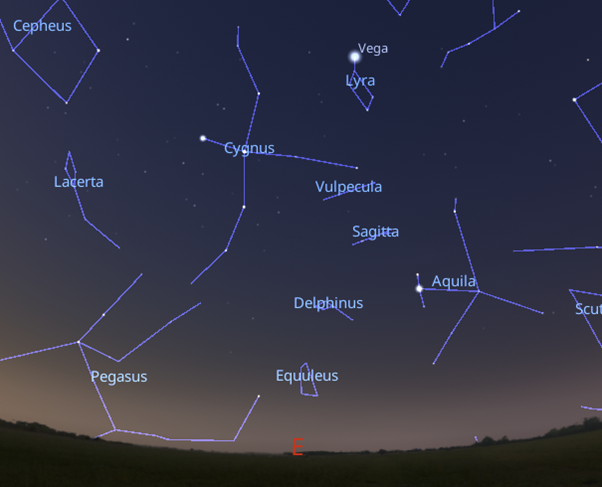
Simulation of the sky on 15th June 2025 at 2320 from Kielder Observatory, the red lines show the “summer triangle” asterism (Credit: Stellarium)
Lyra is a lovely little constellation shaped like an ancient Greek lyre. The story goes that this particular lyre once belonged to Orpheus, an ancient poet whose music could even charm rocks. Vega is a beautiful star and being the 5th brightest in the sky it’s a nice easy target for telescopes, and it’s a fun one for fans of the film/book “Contact” by Carl Sagan!
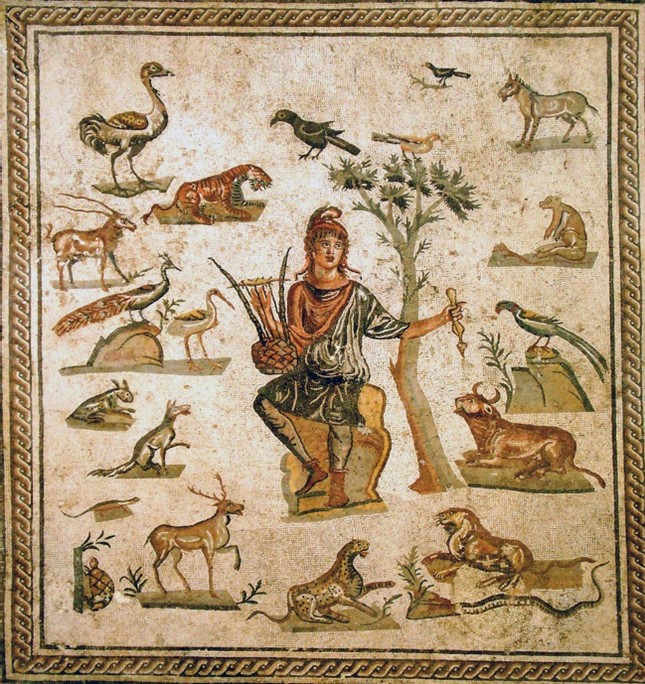
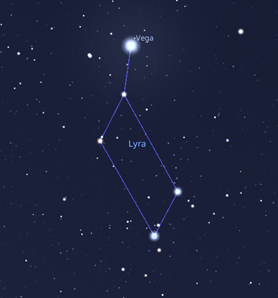
L: Roman floor mosaic showing Orpheus charming animals, from Palermo. R: The constellation Lyra, the double double is circled (Credit: Stellarium)
Just to the left of Vega you should spot another fainter star which has a surprise for those with telescopes to get a closer look. A telescope will reveal this star as a double set of binaries, and we affectionately refer to it as the double double because of this. These 4 stars are around 162 light years away and all orbit around one another. A fifth star in this system was discovered in 1985, but you won’t be able to see that one.
Object of the Month – M57 The Ring Nebula
In Greek mythology, Orpheus was a prophet as well as a musician and poet, so it’s quite appropriate that hidden in his lyre we can catch a glimpse of our Sun’s future with the small but mighty M57, also known as the ring nebula because, well, it looks like a ring. To find it, you want to be looking roughly halfway between the two stars in the base of Lyra. As a general rule, if you can see those stars, it should be dark enough to see this nebula.
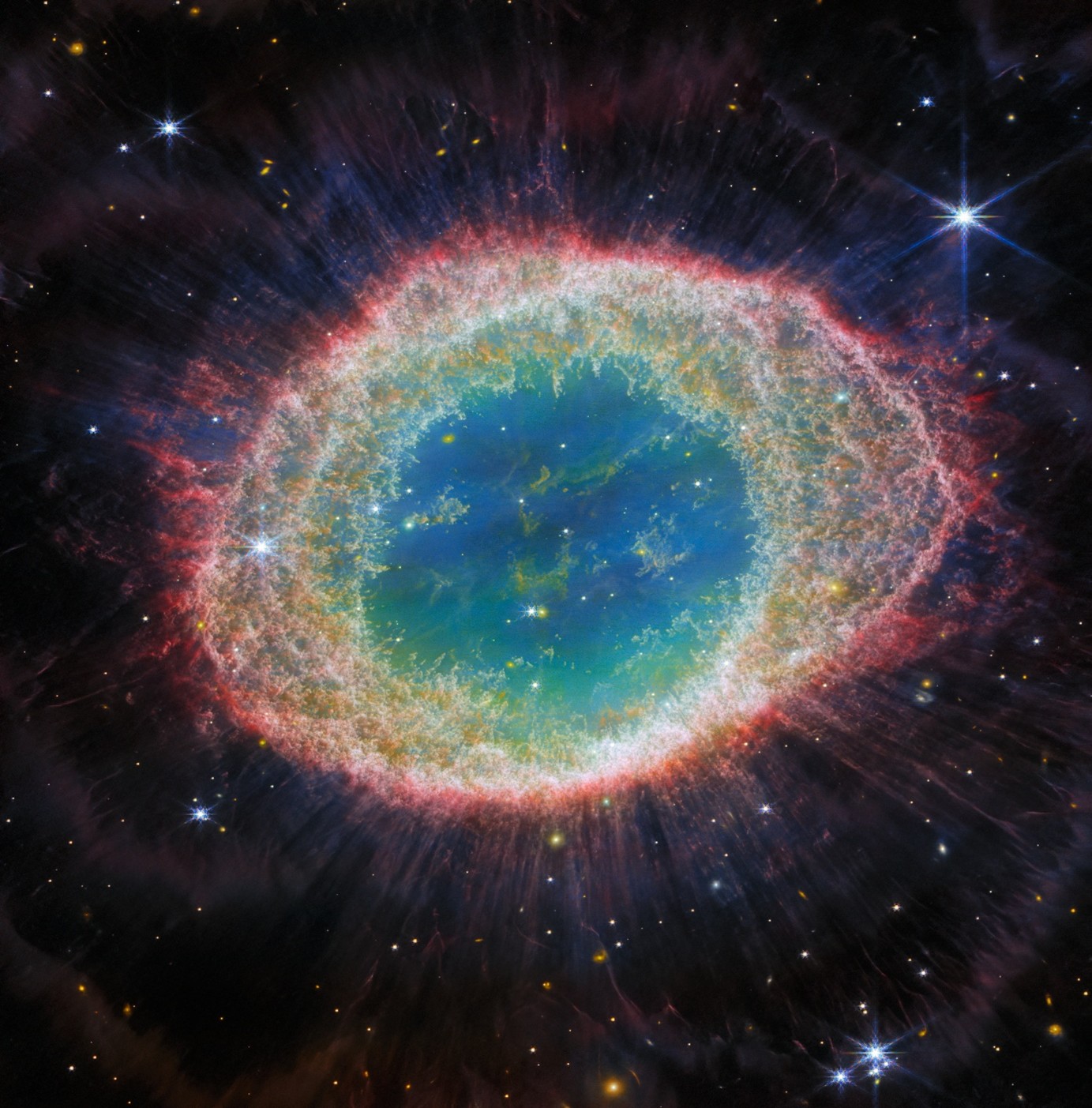
M57 in infra-red as seen using the JWST (Credit: ESA/Webb, NASA, CSA, M. Barlow (UCL), N. Cox (ACRI-ST), R. Wesson (Cardiff University)
Pictures from telescopes such as Hubble and JWST show M57 in stunning detail with a series of colourful rings centred on a small white dwarf star, visible as just a small dot. Viewed by human eyes through a telescope on Earth, those colours become grey, and the nebula resembles a smoke ring suspended in space. M57 is a fantastic example of a planetary nebula which is the end-state of a solar-mass star. Despite the name, planetary nebulas have nothing to do with planets, they just appear rather round like planets.
This type of object is formed as solar-mass stars age and start to swell. More massive stars will go supernova after this stage, generating a vast amount of energy and synthesising elements beyond iron, but not our little solar-mass stars. These stars continue to swell until the outer layers shed away and create our planetary nebulae.
Summer Solstice – 21st June
The summer solstice falls on the 21st of June, marking the shortest day of the year and the start of astronomical summer. The term “solstice” comes from the Latin “sol” (Sun) and “sistere” (to stand still). It doesn’t actually refer to a day so much as a specific moment in the day where the Suns motion (in declination) seems to stop before reversing. In other words, it is the moment the Sun is at its highest in the summer, or the lowest in winter.
Many cultures around the world have been known to mark the solstices with celebrations and festivals, and monuments have been built to be able to determine when the day arrives. In the UK we have Stonehenge which was built to mark the solstices and each year thousands of people gather on this day to watch the Sun rise in line with the Heel Stone at the entrance of the stone circle.
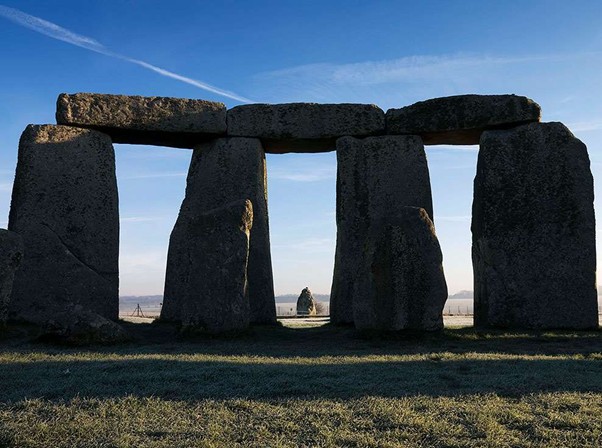
The Heel Stone as seen through Stonehenge, on the 21st June the Sun will rise just to the left of here (Credit: English Heritage)
Planets
It’s a pretty quiet month for planets as even Mars starts to set in the evening sky, but early risers will be able to catch Saturn and Venus in the pre-dawn sky.
Moon
First Quarter: 3rd June
Full Moon: 11th June
Third Quarter: 18th June
New Moon: 25th June
















